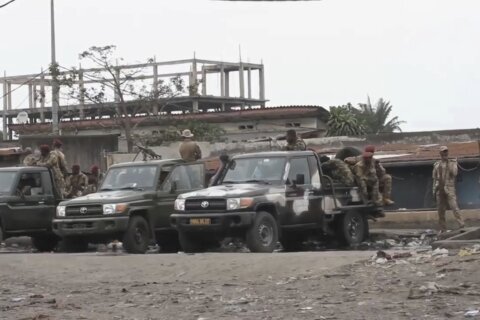DUBAI, United Arab Emirates (AP) — As Iran threatens to retaliate against Israel over the assassination of Hamas leader Ismail Haniyeh in Tehran, the accuracy of the Islamic Republic’s long-vaunted missile program has been called into question.
A new report by experts shared exclusively with The Associated Press suggests one of the advanced missiles Tehran would use in any future attack against Israel is far less accurate than previously thought.
The finding comes months after a U.S.-led coalition shot down many drones and missiles launched by Iran in an April attack on Israel. Other projectiles apparently failed at launch or crashed while in flight.
Here are some takeaways about Iran’s ballistic missile threat:
Iranian missile had poor accuracy
Analysts at the James Martin Center for Nonproliferation Studies examined the Iranian strike on the Nevatim Air Base some 65 kilometers (40 miles) south of Jerusalem in the Negev Desert. They believe Iran used its Emad missile, a variant of the country’s Shahab-3 missile built from a North Korean design.
Assuming Iran targeted Israeli F-35I fighter jet hangars, the James Martin analysts measured the distance between the hangars and the impact zones of the missiles. That gave an average of about 1.2 kilometers (0.75 miles) for the “circular error probable” — a measurement used by experts to determine a weapon’s accuracy based on the radius of a circle that encompasses 50% of where the missiles landed.
That’s far worse than a 500-meter (1,640-foot) error circle first estimated by experts for the Emad. Iran separately advertised the Emad to potential international buyers as having a 50-meter (164-foot) circle.
Many projectiles were shot down in attack
The U.S., the United Kingdom, France and Jordan all shot down incoming fire. The Americans claimed to have downed 80 bomb-carrying drones and at least six ballistic missiles. Israeli missile defenses were also activated, though their initial claim of intercepting 99% of the projectiles appeared to be an exaggeration.
U.S. officials, who spoke on condition of anonymity to discuss intelligence matters, told the AP they assessed that 50% of the Iranian missiles failed at launch or crashed before reaching their target. That raises further doubts about the abilities of Iran’s missile arsenal.
Questions about any future strike by Iran
Iran shares no border with Israel, and the two countries are some 1,000 kilometers (620 miles) apart at the shortest distance. That makes Iran’s missile program vital in any direct military attack. The longer the distances, the greater any slight errors in the missile’s guidance system become, along with the effects of wind and other weather.
Iran could also enlist help from allied militias such as Lebanon’s Hezbollah and Yemen’s Houthi rebels to overwhelm Israel’s defenses. Israel and Hezbollah exchanged heavy fire on Aug. 25.
However, Iran’s poor performance in April and yearslong sabotage campaigns targeting its ballistic missile program raise questions about whether Tehran would be able to accurately strike targets at that distance.
Meanwhile, Iran continues to make threats about its ability to potentially build a nuclear weapon. Pressure over its inability to deter Israel could see it weaponize a program it has long insisted is peaceful.
___
The Associated Press receives support for nuclear security coverage from the Carnegie Corporation of New York and Outrider Foundation. The AP is solely responsible for all content.
Copyright © 2024 The Associated Press. All rights reserved. This material may not be published, broadcast, written or redistributed.






